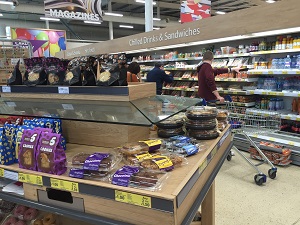 There are lots of reports about the level of in-store purchase decisions by shoppers: the best known is probably the report from POPAI. In their 2014 report they suggest that “82% of all shopping decisions (are) made in the store.” While we can all accept that there is a lot of in-store purchase decision making, is it really this high? And if the level of in-store purchase decisions is high – what should a marketer do about it? In this post I’m going to attempt to cut through the myths about in-store purchase decisions, and consider how marketers, sales professionals and retailers can use this to their advantage.
There are lots of reports about the level of in-store purchase decisions by shoppers: the best known is probably the report from POPAI. In their 2014 report they suggest that “82% of all shopping decisions (are) made in the store.” While we can all accept that there is a lot of in-store purchase decision making, is it really this high? And if the level of in-store purchase decisions is high – what should a marketer do about it? In this post I’m going to attempt to cut through the myths about in-store purchase decisions, and consider how marketers, sales professionals and retailers can use this to their advantage.
What we mean by in-store purchase decisions
Before we go any further, let’s clear up what POPAI mean when they say that 82% of all shopping decisions are made in the store. POPAI asks shoppers which categories and brands they are planning to buy before they start shopping. After the shopper has completed their shopping, the actual purchases are compared with the plan. Anything purchased that doesn’t exactly fit the plan counts as a decision made in-store.
The first watch out is the definition of ‘planned’. The 82% actually refers to purchases not “specifically planned”. According to their report, any purchase referred to generically (e.g. a category), but not specifically by brand in the pre-store planning interview, counts as an ‘unplanned purchase’. So if my stated plan was ketchup, but I didn’t mention a brand; then if I buy a ketchup, that counts as an in-store decision. So if I only ever buy one brand of ketchup, but didn’t actually mention that brand during the interview – that’s a decision. What if I couldn’t remember the brand name, but I always buy the same pack? That’s still an in-store decision.
In-store purchase decisions : what does POPAI’s number actually mean?
The number quoted by POPAI reflects the “number of purchases made in-store that were not consciously planned at a category and brand level prior to the shop”. It doesn’t trip off the tongue quite as well as “82% of purchase decisions made in-store”, but it is a little more accurate! And nothing wrong with that: it still shows that an awful lot of decisions are being made in-store, just maybe not quite as many as POPAI suggests.
Just because I don’t list a category and a brand, doesn’t mean there isn’t a plan
POPAI states that they ask about planned categories and brands. But categories and brands are ‘manufacturer speak’. Some shoppers may have plans that don’t include this language. ‘Some drinks for the party’: no category or brand reference, but still a plan. “Something for dinner” – again, it’s a plan that doesn’t fit into the POPAI definition. If a shopper is looking for ‘something for dinner’ there is clearly space to influence that purchase decision in the store. But it is disingenuous to suggest 82% of purchase decisions are made in store. The decision to buy a meal (and which shop to buy it in) were clearly two decisions made pre-store, and neither would be counted by POPAI.
Just because a shopper doesn’t have a plan, doesn’t mean you can get into their basket
The real danger I see in this is the assumption that just because a shopper hadn’t consciously planned to make the purchase on 82% of occasions, that somehow that means that we can win in-store on those occasions. I’m afraid not. The reality is that yes, in-store stimuli are clearly at work, and are clearly important. But the implication (not one that POPAI makes overtly, I hasten to add) that 82% of purchase decisions are a ‘blank page’ is patently untrue. And just because I don’t have a robust, conscious plan to buy your competitor, doesn’t mean I might consider you. Going back to the ketchup illustration. I might see a sign for the Heinz brand, which reminds me that I might need ketchup. But when I go to the shelf I buy the private label product I always buy. I didn’t have a plan, but I was never going to buy the brand. Just because a shopper doesn’t have a plan, doesn’t mean you can get into their basket.
In-store purchase decisions: important, but beware the generalizations
Putting all of this misinterpretation aside, whatever the number is, there is a number. The in-store environment is important. But these numbers are averages – generalizations that can be misleading and dangerous. It will vary dramatically by category. In our shopper research, we’ve seen categories (snacks, for example) with very high levels of in-store switching, and other categories (kids milk for example) with tiny levels of in-store decisions (below 10%).
Further, different channels attract different shoppers and different missions, so we can expect to see the level of influence vary dramatically by channel. The number will vary by shopper segment too as different shoppers will of course exhibit quite different behaviors. So until we are clear on which shoppers we are targeting, and in which channels, the number is, to say the least, a little academic to say the least.
Understanding in-store purchase decisions is critical
To be clear, I don’t have a problem with POPAI (though a little less hyperbole on the headline statistic wouldn’t go amiss!) They work hard to raise awareness of the importance of the in-store environment as a medium for influencing shoppers. But as a raw, generic statistic, it is low value and perhaps dangerous. As with all data points, it’s essential to make sure you understand exactly what the data means, and use it only as a jumping off point to start asking high value questions about your business. What is the number for your category? How does it vary by channel? How does it vary by shopper segment? How does it vary by shopping trip or mission? Then we’re really getting somewhere!
For more on understanding shoppers, and using this to drive more effective marketing, check out the blog at www.engageconsultants.com for free advice and insights, every week.





